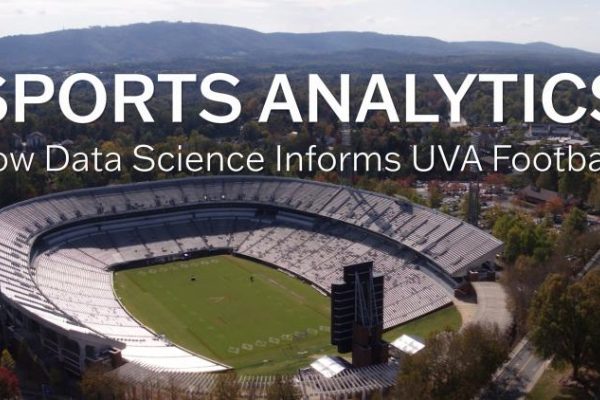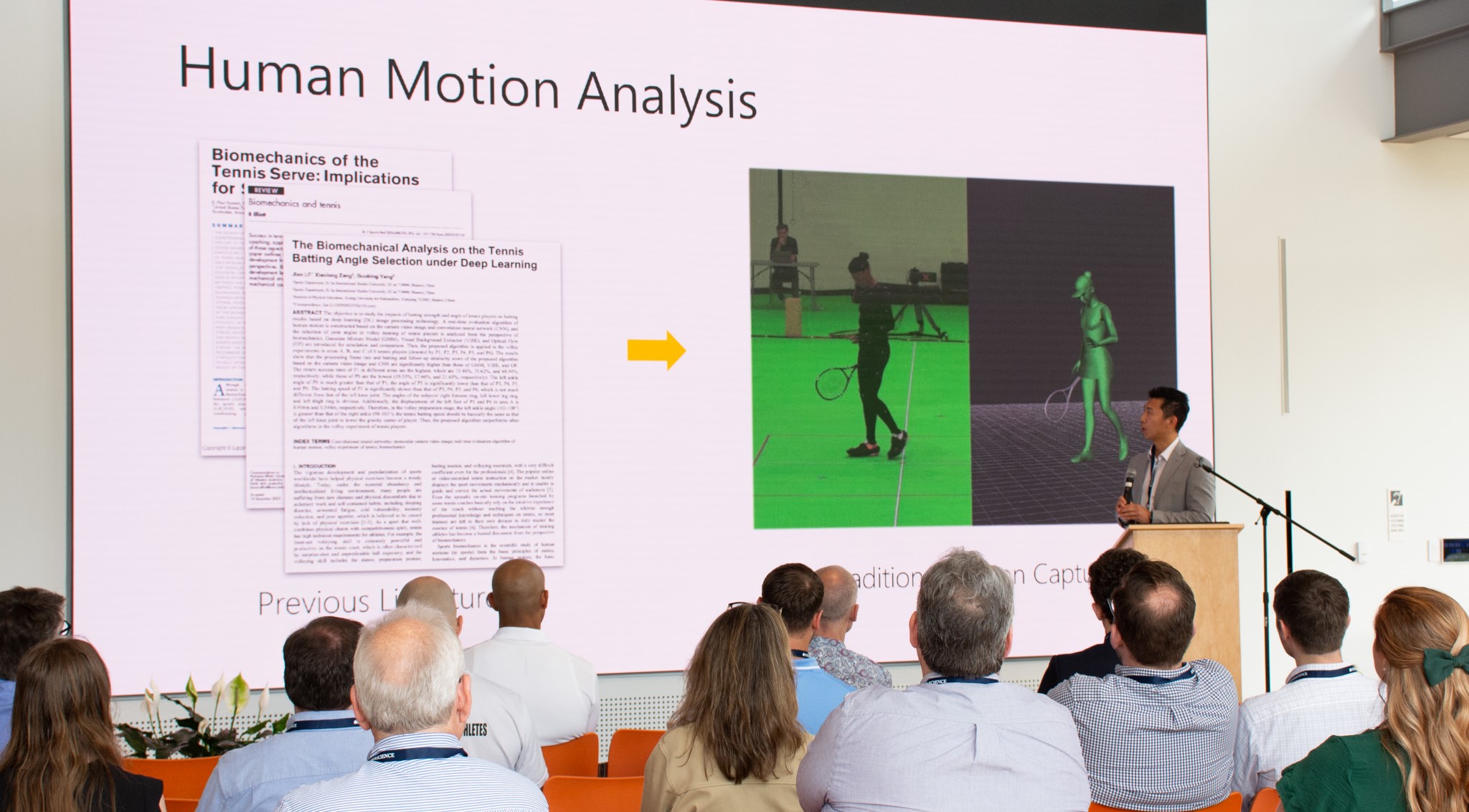
UVA Launches Inaugural Sports Research and Technology Innovation Summit
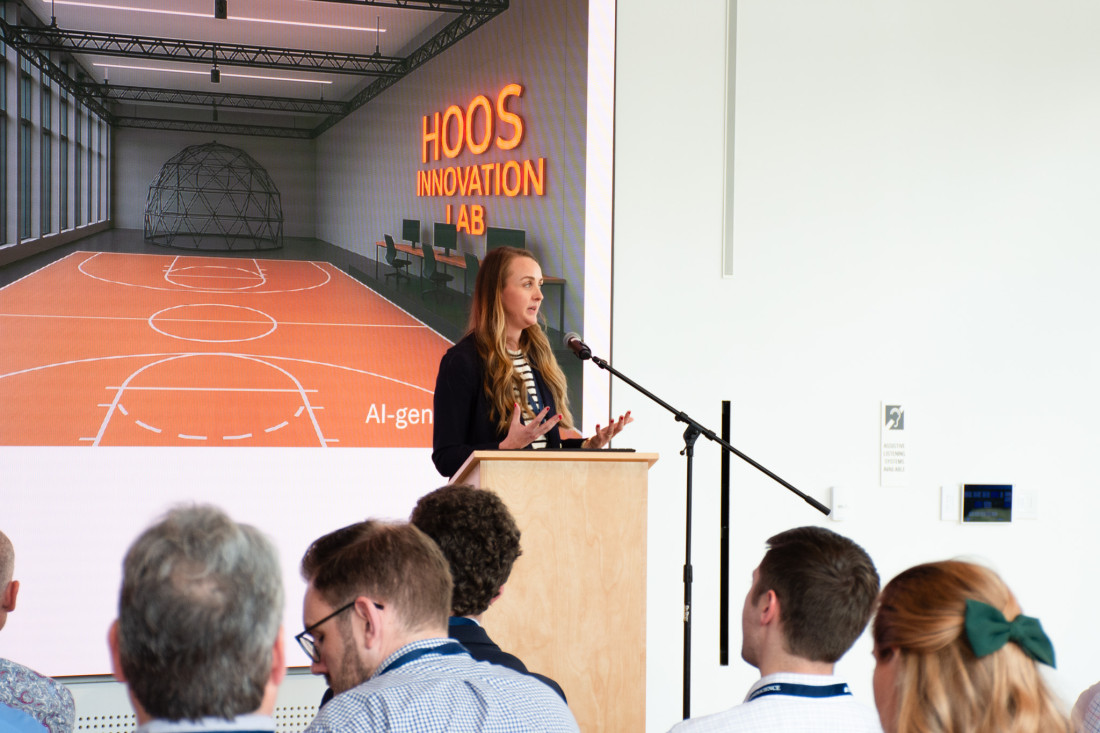
The University of Virginia School of Data Science hosted its first Sports Research and Technology Innovation Summit on May 8, 2025, marking a bold step forward in connecting academic research with industry applications in sports science, human performance, and athlete health. The day-long summit, held at the School of Data Science’s Capital One Hub, brought together 70-plus faculty, researchers, and industry professionals across disciplines to explore translational research, foster collaboration, and spark innovation at the intersection of data, sports, and society.
Opening the summit, Assistant Professor of Data Science Natalie Kupperman welcomed guests with a call to action for deeper academic-industry partnerships. Emphasizing UVA’s strengths in athletics, medical research, and data science, she framed the event as a launchpad for scalable technologies and collaborative breakthroughs that can improve athletic performance and well-being.
"We not only have high-performing athletics in the top four sports and all the way through the Olympic pipeline, and an amazing ecosystem of athletes here in Charlottesville, but UVA has also been putting a lot of effort into the entrepreneurial space," Kupperman said. She noted how the labs represented at the event and around the University can really help advance the innovation pipeline.
Kupperman introduced attendees to two emerging initiatives she is working on: the Health Outcomes and Optimization in Sports (HOOS) Innovation Lab, a high-performance facility focused on athlete-centered technology; and SARA, the Simulated Athlete for Research and Analysis, a female digital twin model designed to improve training and injury prevention for women athletes.
Lightning Talks Highlight UVA's Interdisciplinary Sports Research
The event featured a series of fast-paced lightning talks that showcased diverse research happening across UVA. These included machine learning, biomechanics, wearable technology, responsible AI, and digital tools—underscoring the breadth and depth of UVA’s sports research ecosystem.

Visual Intelligence in Athletic Performance
Quantitative Foundation Associate Professor of Data Science Stephen Baek and Ph.D. student Jason Wang from the Visual Intelligence Laboratory @ UVA (VIVA Lab) presented on using computer vision and physics-aware AI to model athletic movement—like analyzing thousands of tennis serves from US Open footage to uncover patterns of performance. Their work aims to equip coaches and trainers with practical, data-driven insights. Baek noted that statistics naturally focus on the average trend, but professional athletes often defy those numbers.
"We have to develop a model that can cope with those special outliers as opposed to following the trend of the average," Baek said. He is working to translate his experience with extreme dynamics in things like propellants and explosives to the physics of peak human performance.
Innovations in Injury Prevention and Recovery
Jay Hertel from the Exercise and Sport Injury Laboratory (EASIL) highlighted advances in athletic training, wearable sensor technology, and concussion research. Collaborations across departments have led to new EASIL initiatives like the SPRINT ACL Rehabilitation Program and a baseline concussion assessment program involving thousands of student-athletes at the collegiate and even high-school level. Yet, he noted that the world of athlete monitoring still has a small sample size problem, and partnering to collect even more data can help keep as many athletes as healthy as possible.
Responsible AI in Sports Analytics
Assistant Professor of Data Science Tom Hartvigsen and Ph.D. student Zack Gottesman from the Responsible AI in Varying Environments (RAVE) research group discussed using large language models to analyze and interpret time series data, as well as ensuring the tools are both effective and ethical in real-world applications. Examples included tracking a player's wearable device data to detect their levels of stress over time to determine if they're ready to return to training, or even using win probability data through the course of a game to infer what events were happening at different points in time.
Tools for Scalable Research Using Wearable Technology
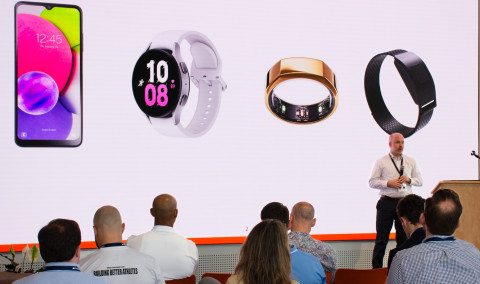
Mark Rucker, associate director of the Digital Technology Core, introduced this strategic initiative that aims to support UVA researchers by offering a range of in-house services aimed at lowering research costs and enhancing project competitiveness.
Rucker discussed the DTC's Digital Trails app, which helps researchers collect and analyze real-time health data using devices like smartwatches and custom-built apps. This technology allows for rapid study prototyping without coding, empowering researchers across disciplines to incorporate digital tools into their work.
Industry Leaders Share Real-World Innovations at Sports Summit
A highlight of the summit was the opportunity to hear directly from industry leaders shaping the future of sports performance, safety, and analytics. Speakers from cutting-edge companies—many with strong UVA ties—shared how their tools and technologies are being used to transform decision-making and outcomes across professional, collegiate, and youth sports.
These sessions brought into focus how the University's data-driven research is not just theoretical but is actively informing product development, diagnostics, and injury prevention strategies across the sports industry.
Muscle Mapping Through MRI: Springbok Analytics
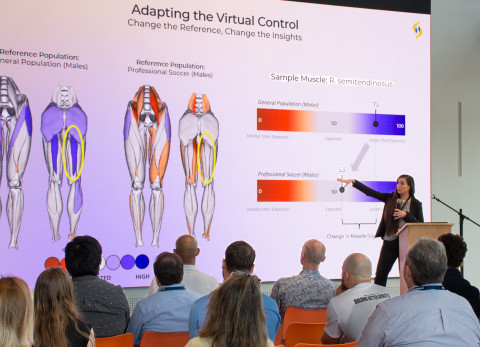
Kicking off the industry talks, Olivia DuCharme of Springbok Analytics presented the company’s approach to muscle health. With imaging technology originating from pediatric research on cerebral palsy, Springbok’s AI-powered system creates 3D digital twins from MRI scans to provide detailed insight into muscle and bone structures, asymmetries, and tissue composition.
These insights support injury recovery, performance optimization, and population-level research.
Springbok’s growing dataset now includes over 300 athletes across multiple sports. The company collaborates with teams to stratify data by position, allowing coaches to tailor interventions. DuCharme also acknowledged concerns around data privacy, and she emphasized athlete-first approaches to data sharing and interpretation.
Connected Performance Ecosystems: Hudl
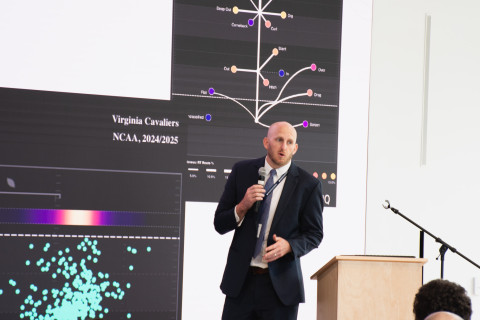
Matt Edwards, an alumnus of the UVA School of Data Science online master’s program, gave an insider look at Hudl, a leader in sports video and performance analysis. Serving more than 230,000 teams across 40+ sports, Hudl combines video, wearables, and event data into a connected ecosystem for teams ranging from high school to the German Bundesliga and the NBA.
Edwards highlighted Hudl’s growing suite of AI-enhanced products, from automated player tracking to advanced scouting tools that support recruiting and development. The platform’s expansive user base—over 8 million strong—relies on Hudl not only to analyze game film but to gain a competitive edge through data-driven insights.
As questions turned to data ownership and ethical concerns, Edwards confirmed that schools maintain control over footage and athlete participation, reinforcing Hudl’s commitment to transparency.
Engineering Safer Athletes: Biocore and the NFL
Wrapping up the industry session was Hans Deutmeyer, president of Biocore, a sports science consultancy spun out of UVA that now partners with the NFL and other major sports organizations to prevent injuries and enhance performance.
For example, through its Digital Athlete Program, Biocore integrates NFL player tracking, motion capture, video analysis, and injury records to build predictive models for injury risk and training outcomes. Deutmeyer explained how rule changes—such as the NFL banning the hip drop tackle—are grounded in these insights, with measurable reductions in concussion and lower-limb injuries.
"We actually have data that the NFL does not have because we have this unique position where we sit between the Players Association and the league," he said. "And from this, we can do a number of modeling simulations and to start to predict outcomes—outcomes primarily around making the game safer."
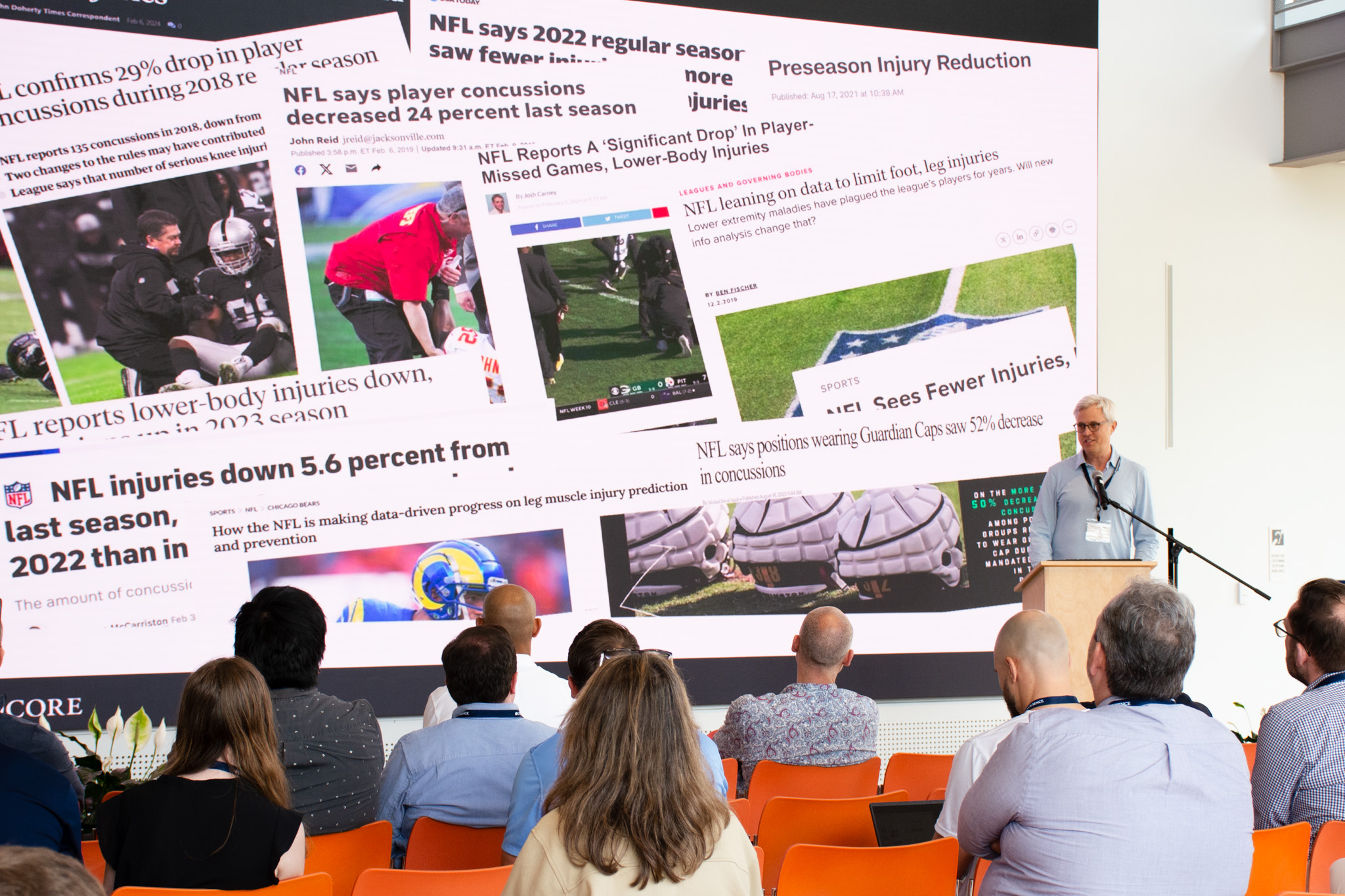
Biocore’s work also extends to performance optimization. Case studies included improving NBA shooting mechanics and analyzing ACL injuries in real time. The company’s combination of biomechanics, data science, and engineering is helping sports organizations create a 360-degree view of the athlete, from training to competition.
Keynote Fireside Chat Explores the Power of Public-Private Synergy
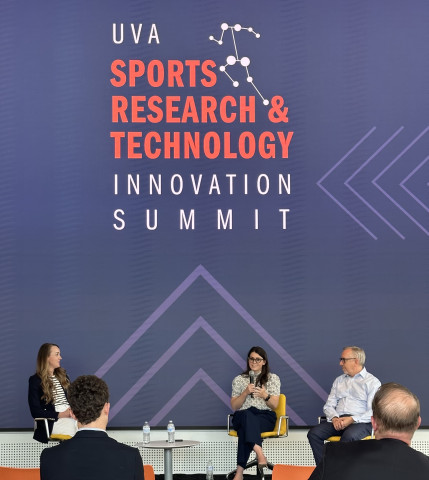
The summit concluded with a forward-looking keynote discussion titled “Catalyzing Innovation: A Fireside Chat on Public-Private Synergy,” featuring Kelly Ard, assistant vice president for UVA Corporate and Foundation Relations, and Rich Chylla, executive director of the UVA Licensing & Ventures Group. Moderated by Kupperman, the conversation explored how universities and industry can collaborate to translate academic research into real-world impact.
Drawing on decades of experience in technology transfer and strategic partnerships, Ard and Chylla emphasized that innovation thrives when academia and industry engage early, communicate openly, and pursue long-term relationships over short-term wins. Chylla highlighted UVA’s record highs in licensing deals and startup launches, while Ard shared how her office connects UVA’s research strengths with industry needs through philanthropy and sponsored research.
They noted that UVA’s interdisciplinary culture and entrepreneurial mindset uniquely position it to build successful partnerships. A promising development underway is an AI-driven collaboration platform that will help match researchers with industry opportunities more efficiently, and these partnerships can potentially leverage UVA’s internal funds to de-risk technology and accelerate innovation.
The summit not only showcased UVA’s interdisciplinary strengths but also affirmed the University’s role as a national leader in shaping the future of sports science and athlete health. From real-time wearable data and digital athlete modeling to public-private innovation strategies, the event offered a comprehensive look at how data science is transforming performance, safety, and equity in sports. With momentum building and partnerships forming, the School of Data Science is poised to make this summit the cornerstone of a growing, impactful movement—one where data drives discovery and athletes benefit at every level.




